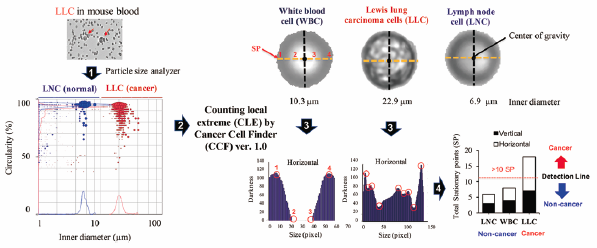- 著者
- Babita Shashni Shinya Ariyasu Reisa Takeda Toshihiro Suzuki Shota Shiina Kazunori Akimoto Takuto Maeda Naoyuki Aikawa Ryo Abe Tomohiro Osaki Norihiko Itoh Shin Aoki
- 出版者
- The Pharmaceutical Society of Japan
- 雑誌
- Biological and Pharmaceutical Bulletin (ISSN:09186158)
- 巻号頁・発行日
- vol.41, no.4, pp.487-503, 2018-04-01 (Released:2018-04-01)
- 参考文献数
- 45
- 被引用文献数
- 34 65
Detection of anomalous cells such as cancer cells from normal blood cells has the potential to contribute greatly to cancer diagnosis and therapy. Conventional methods for the detection of cancer cells are usually tedious and cumbersome. Herein, we report on the use of a particle size analyzer for the convenient size-based differentiation of cancer cells from normal cells. Measurements made using a particle size analyzer revealed that size parameters for cancer cells are significantly greater (e.g., inner diameter and width) than the corresponding values for normal cells (white blood cells (WBC), lymphocytes and splenocytes), with no significant difference in shape parameters (e.g., circularity and convexity). The inner diameter of many cancer cell lines is greater than 10 µm, in contrast to normal cells. For the detection of WBC having similar size to that of cancer cells, we developed a PC software “Cancer Cell Finder” that differentiates them from cancer cells based on brightness stationary points on a cell surface. Furthermore, the aforementioned method was validated for cancer cell/clusters detection in spiked mouse blood samples (a B16 melanoma mouse xenograft model) and circulating tumor cell cluster-like particles in the cat and dog (diagnosed with cancer) blood samples. These results provide insights into the possible applicability of the use of a particle size analyzer in conjunction with PC software for the convenient detection of cancer cells in experimental and clinical samples for theranostics.
- 著者
- Wataru Aoi Takashi Maoka Ryo Abe Mayuko Fujishita Kumi Tominaga
- 出版者
- SOCIETY FOR FREE RADICAL RESEARCH JAPAN
- 雑誌
- Journal of Clinical Biochemistry and Nutrition (ISSN:09120009)
- 巻号頁・発行日
- vol.62, no.2, pp.161-166, 2018 (Released:2018-03-01)
- 参考文献数
- 44
- 被引用文献数
- 34
Astaxanthin, a natural antioxidant, exists in non-esterified and esterified forms. Although it is known that astaxanthin can improve exercise endurance and cause metabolic improvement in skeletal muscle, the effects of the two different forms are unclear. We investigated the effects of the different forms of astaxanthin on endurance in mice. Eight-week-old ICR mice were divided into four groups: control; astaxanthin extracted from Haematococcus pluvialis in an esterified form; astaxanthin extracted from Phaffia rhodozyma in a non-esterified form; and astaxanthin synthesized chemically in a non-esterified form. After 5 weeks of treatment, each group was divided into sedentary and exercise groups. In the group fed astaxanthin from Haematococcus, the running time to exhaustion was longest, and the plasma and tissue concentrations of astaxanthin were significantly higher than those in the other groups. Astaxanthin from Haematococcus increased 5'-adenosine monophosphate-activated protein kinase levels in the skeletal muscle. Although the mice in the Haematococcus group ran for longer, hexanoyl lysine adduct levels in the skeletal muscle mitochondria were similar in the control and Haematococcus groups. Our results suggested that esterified astaxanthin promoted energy production and protected tissues from oxidative damage during exercise owing to its favorable absorption properties, leading to a longer running time.
